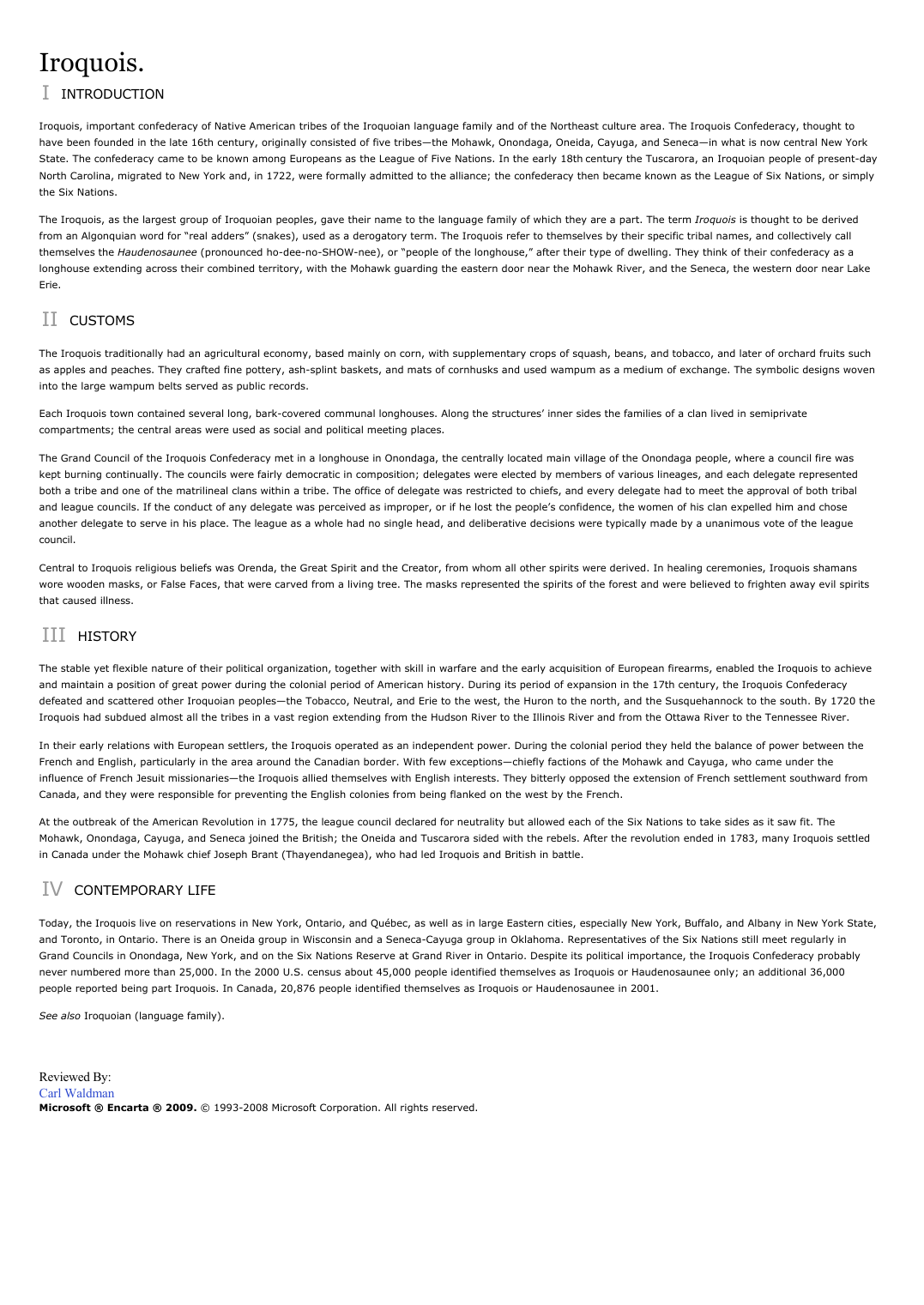Iroquois.
Publié le 06/12/2021
Extrait du document
Ci-dessous un extrait traitant le sujet : Iroquois.. Ce document contient 921 mots. Pour le télécharger en entier, envoyez-nous un de vos documents grâce à notre système d’échange gratuit de ressources numériques ou achetez-le pour la modique somme d’un euro symbolique. Cette aide totalement rédigée en format pdf sera utile aux lycéens ou étudiants ayant un devoir à réaliser ou une leçon à approfondir en : Echange
Iroquois.
I
INTRODUCTION
Iroquois, important confederacy of Native American tribes of the Iroquoian language family and of the Northeast culture area. The Iroquois Confederacy, thought to
have been founded in the late 16th century, originally consisted of five tribes--the Mohawk, Onondaga, Oneida, Cayuga, and Seneca--in what is now central New York
State. The confederacy came to be known among Europeans as the League of Five Nations. In the early 18th century the Tuscarora, an Iroquoian people of present-day
North Carolina, migrated to New York and, in 1722, were formally admitted to the alliance; the confederacy then became known as the League of Six Nations, or simply
the Six Nations.
The Iroquois, as the largest group of Iroquoian peoples, gave their name to the language family of which they are a part. The term Iroquois is thought to be derived
from an Algonquian word for "real adders" (snakes), used as a derogatory term. The Iroquois refer to themselves by their specific tribal names, and collectively call
themselves the Haudenosaunee (pronounced ho-dee-no-SHOW-nee), or "people of the longhouse," after their type of dwelling. They think of their confederacy as a
longhouse extending across their combined territory, with the Mohawk guarding the eastern door near the Mohawk River, and the Seneca, the western door near Lake
Erie.
II
CUSTOMS
The Iroquois traditionally had an agricultural economy, based mainly on corn, with supplementary crops of squash, beans, and tobacco, and later of orchard fruits such
as apples and peaches. They crafted fine pottery, ash-splint baskets, and mats of cornhusks and used wampum as a medium of exchange. The symbolic designs woven
into the large wampum belts served as public records.
Each Iroquois town contained several long, bark-covered communal longhouses. Along the structures' inner sides the families of a clan lived in semiprivate
compartments; the central areas were used as social and political meeting places.
The Grand Council of the Iroquois Confederacy met in a longhouse in Onondaga, the centrally located main village of the Onondaga people, where a council fire was
kept burning continually. The councils were fairly democratic in composition; delegates were elected by members of various lineages, and each delegate represented
both a tribe and one of the matrilineal clans within a tribe. The office of delegate was restricted to chiefs, and every delegate had to meet the approval of both tribal
and league councils. If the conduct of any delegate was perceived as improper, or if he lost the people's confidence, the women of his clan expelled him and chose
another delegate to serve in his place. The league as a whole had no single head, and deliberative decisions were typically made by a unanimous vote of the league
council.
Central to Iroquois religious beliefs was Orenda, the Great Spirit and the Creator, from whom all other spirits were derived. In healing ceremonies, Iroquois shamans
wore wooden masks, or False Faces, that were carved from a living tree. The masks represented the spirits of the forest and were believed to frighten away evil spirits
that caused illness.
III
HISTORY
The stable yet flexible nature of their political organization, together with skill in warfare and the early acquisition of European firearms, enabled the Iroquois to achieve
and maintain a position of great power during the colonial period of American history. During its period of expansion in the 17th century, the Iroquois Confederacy
defeated and scattered other Iroquoian peoples--the Tobacco, Neutral, and Erie to the west, the Huron to the north, and the Susquehannock to the south. By 1720 the
Iroquois had subdued almost all the tribes in a vast region extending from the Hudson River to the Illinois River and from the Ottawa River to the Tennessee River.
In their early relations with European settlers, the Iroquois operated as an independent power. During the colonial period they held the balance of power between the
French and English, particularly in the area around the Canadian border. With few exceptions--chiefly factions of the Mohawk and Cayuga, who came under the
influence of French Jesuit missionaries--the Iroquois allied themselves with English interests. They bitterly opposed the extension of French settlement southward from
Canada, and they were responsible for preventing the English colonies from being flanked on the west by the French.
At the outbreak of the American Revolution in 1775, the league council declared for neutrality but allowed each of the Six Nations to take sides as it saw fit. The
Mohawk, Onondaga, Cayuga, and Seneca joined the British; the Oneida and Tuscarora sided with the rebels. After the revolution ended in 1783, many Iroquois settled
in Canada under the Mohawk chief Joseph Brant (Thayendanegea), who had led Iroquois and British in battle.
IV
CONTEMPORARY LIFE
Today, the Iroquois live on reservations in New York, Ontario, and Québec, as well as in large Eastern cities, especially New York, Buffalo, and Albany in New York State,
and Toronto, in Ontario. There is an Oneida group in Wisconsin and a Seneca-Cayuga group in Oklahoma. Representatives of the Six Nations still meet regularly in
Grand Councils in Onondaga, New York, and on the Six Nations Reserve at Grand River in Ontario. Despite its political importance, the Iroquois Confederacy probably
never numbered more than 25,000. In the 2000 U.S. census about 45,000 people identified themselves as Iroquois or Haudenosaunee only; an additional 36,000
people reported being part Iroquois. In Canada, 20,876 people identified themselves as Iroquois or Haudenosaunee in 2001.
See also Iroquoian (language family).
Reviewed By:
Carl Waldman
Microsoft ® Encarta ® 2009. © 1993-2008 Microsoft Corporation. All rights reserved.
Iroquois.
I
INTRODUCTION
Iroquois, important confederacy of Native American tribes of the Iroquoian language family and of the Northeast culture area. The Iroquois Confederacy, thought to
have been founded in the late 16th century, originally consisted of five tribes--the Mohawk, Onondaga, Oneida, Cayuga, and Seneca--in what is now central New York
State. The confederacy came to be known among Europeans as the League of Five Nations. In the early 18th century the Tuscarora, an Iroquoian people of present-day
North Carolina, migrated to New York and, in 1722, were formally admitted to the alliance; the confederacy then became known as the League of Six Nations, or simply
the Six Nations.
The Iroquois, as the largest group of Iroquoian peoples, gave their name to the language family of which they are a part. The term Iroquois is thought to be derived
from an Algonquian word for "real adders" (snakes), used as a derogatory term. The Iroquois refer to themselves by their specific tribal names, and collectively call
themselves the Haudenosaunee (pronounced ho-dee-no-SHOW-nee), or "people of the longhouse," after their type of dwelling. They think of their confederacy as a
longhouse extending across their combined territory, with the Mohawk guarding the eastern door near the Mohawk River, and the Seneca, the western door near Lake
Erie.
II
CUSTOMS
The Iroquois traditionally had an agricultural economy, based mainly on corn, with supplementary crops of squash, beans, and tobacco, and later of orchard fruits such
as apples and peaches. They crafted fine pottery, ash-splint baskets, and mats of cornhusks and used wampum as a medium of exchange. The symbolic designs woven
into the large wampum belts served as public records.
Each Iroquois town contained several long, bark-covered communal longhouses. Along the structures' inner sides the families of a clan lived in semiprivate
compartments; the central areas were used as social and political meeting places.
The Grand Council of the Iroquois Confederacy met in a longhouse in Onondaga, the centrally located main village of the Onondaga people, where a council fire was
kept burning continually. The councils were fairly democratic in composition; delegates were elected by members of various lineages, and each delegate represented
both a tribe and one of the matrilineal clans within a tribe. The office of delegate was restricted to chiefs, and every delegate had to meet the approval of both tribal
and league councils. If the conduct of any delegate was perceived as improper, or if he lost the people's confidence, the women of his clan expelled him and chose
another delegate to serve in his place. The league as a whole had no single head, and deliberative decisions were typically made by a unanimous vote of the league
council.
Central to Iroquois religious beliefs was Orenda, the Great Spirit and the Creator, from whom all other spirits were derived. In healing ceremonies, Iroquois shamans
wore wooden masks, or False Faces, that were carved from a living tree. The masks represented the spirits of the forest and were believed to frighten away evil spirits
that caused illness.
III
HISTORY
The stable yet flexible nature of their political organization, together with skill in warfare and the early acquisition of European firearms, enabled the Iroquois to achieve
and maintain a position of great power during the colonial period of American history. During its period of expansion in the 17th century, the Iroquois Confederacy
defeated and scattered other Iroquoian peoples--the Tobacco, Neutral, and Erie to the west, the Huron to the north, and the Susquehannock to the south. By 1720 the
Iroquois had subdued almost all the tribes in a vast region extending from the Hudson River to the Illinois River and from the Ottawa River to the Tennessee River.
In their early relations with European settlers, the Iroquois operated as an independent power. During the colonial period they held the balance of power between the
French and English, particularly in the area around the Canadian border. With few exceptions--chiefly factions of the Mohawk and Cayuga, who came under the
influence of French Jesuit missionaries--the Iroquois allied themselves with English interests. They bitterly opposed the extension of French settlement southward from
Canada, and they were responsible for preventing the English colonies from being flanked on the west by the French.
At the outbreak of the American Revolution in 1775, the league council declared for neutrality but allowed each of the Six Nations to take sides as it saw fit. The
Mohawk, Onondaga, Cayuga, and Seneca joined the British; the Oneida and Tuscarora sided with the rebels. After the revolution ended in 1783, many Iroquois settled
in Canada under the Mohawk chief Joseph Brant (Thayendanegea), who had led Iroquois and British in battle.
IV
CONTEMPORARY LIFE
Today, the Iroquois live on reservations in New York, Ontario, and Québec, as well as in large Eastern cities, especially New York, Buffalo, and Albany in New York State,
and Toronto, in Ontario. There is an Oneida group in Wisconsin and a Seneca-Cayuga group in Oklahoma. Representatives of the Six Nations still meet regularly in
Grand Councils in Onondaga, New York, and on the Six Nations Reserve at Grand River in Ontario. Despite its political importance, the Iroquois Confederacy probably
never numbered more than 25,000. In the 2000 U.S. census about 45,000 people identified themselves as Iroquois or Haudenosaunee only; an additional 36,000
people reported being part Iroquois. In Canada, 20,876 people identified themselves as Iroquois or Haudenosaunee in 2001.
See also Iroquoian (language family).
Reviewed By:
Carl Waldman
Microsoft ® Encarta ® 2009. © 1993-2008 Microsoft Corporation. All rights reserved.
↓↓↓ APERÇU DU DOCUMENT ↓↓↓

































